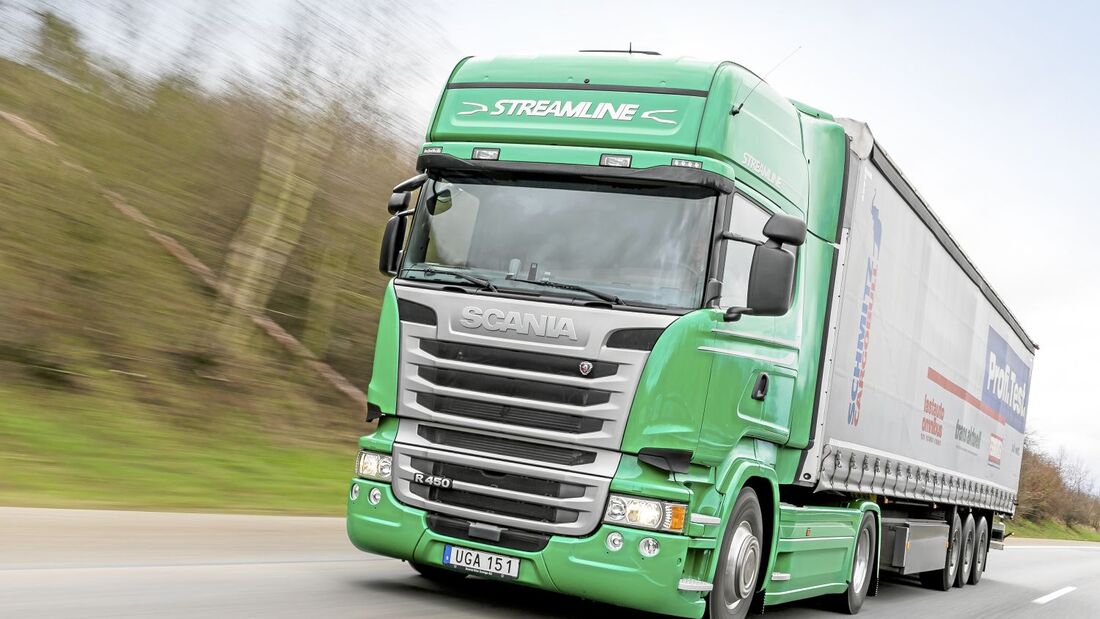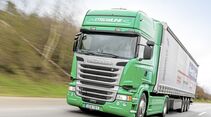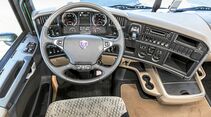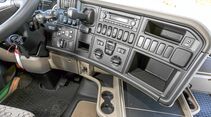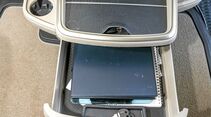Was it all a mistake? This is the question that many engine designers from the EGR faction are probably asking themselves. EGR stands for exhaust-gas recirculation and—in combination with SCR technology and particulate filters—was regarded as the ideal Euro 6 solution as recently as two or three years ago. The entire European commercial vehicle sector favored this technology for complying with the new regulation. The only holdouts were the Iveco engine designers in Arbon, Switzerland. They relied on increased use of SCR to dispense with EGR. This method has been named SCR-only since then.
Being very adventuresome with its engines anyway, Scania then introduced EGR-free five-cylinder engines and supplemented them in late 2013 with the first six-cylinder engine rated at 360 or 410 hp (265 or 302 kW). One year later, they were followed by a 450-hp (331-kW) version based on the existing EGR engine of the same power. The conversion to SCR-only did not affect the basic engine parameters. In both cases, the 130-mm bore and 160-mm stroke result in a displacement of 12.7 liters. The rated power, maximum torque and the associated revs also match.
SCR-only improves the internal engine efficiency
The main advantage of SCR-only lines in the extremely high combustion temperatures possible when using SCR, which ultimately lead to better efficiency within the engine. However, because this method drastically increases the formation of nitrogen oxides, they must be combated with plenty of AdBlue—but this isn´t much of a problem, given the prices for AdBlue. In short: The 410-hp engine was much in the news with its significantly reduced consumption, and it is now highly popular on the road and at construction sites. This begs the question of whether, all things considered, dispensing with EGR and using SCR-only isn´t the better solution after all.
Engine brake only
In Scania´s case, it is more than just the SCR-only technology that reduces consumption so significantly. A contribution is also made by the many electronic assistants like Scania Cruise Control Active Prediction (CCAP), Eco-roll and the skilful and expanded collaboration of these assistants with the engine and gearbox control systems. Another contributing factor is an improved retarder that is almost lossless when not in use. It accounts for around one percent of diesel savings. This Scania-built retarder costs almost 4,000 euro more, but engine brake only is almost out of the question for this Scania truck. The reason is that the low braking power (256 kW), which furthermore is available only from a noisy speed of 2,400 rpm, is rarely adequate to cope with a gross vehicle weight of 40 tons in practice.
The G410, equipped with the first six-cylinder SCR-only engine from Scania, gained a lot of attention when it was tested around a year go and put a good scare into the competition with its low consumption values. The Swedes were able to distinguish themselves from the competition by around two to three liters per 100 kilometers.
AdBlue consumption skyrockets
Although the AdBlue consumption of such engines increases dramatically, easily reaching two-and-a-half to three times that of engines operating with a cooled EGR system, the extra cost in euro is rather modest. EGR engines require around one liter of AdBlue, which corresponds to 20 to 45 cents per 100 kilometers. This figure is 2.55 liters for the Scania R450, which corresponds to half a liter of diesel in the most favorable case (20 cents per liter).
32.0 liters per 100 kilometers
This was the diesel consumption of the G410 in the test report at the time—plus around two liters of AdBlue. At the time, the new 420, 430 and 450 Mercedes Actros trucks had set new records for Euro-6 tractor-trailers, with values of just under 34 to just under 35 liters per 100 kilometers. The Scania R450 now needed only 32.0 liters per 100 kilometers to cover the topologically demanding test route.
Mercedes engines now also work with predictive cruise control and an improved Eco-roll function, of course, so that today´s test values should be around one liter less. Nevertheless, the R450 is still the most economical truck on the test route to date—even including the high AdBlue consumption required the system.
There are three reasons for the lower consumption compared to the technically identical G410. One of them is the aforementioned retarder with the designation R4100D. Another factor is the power train design. Although the G;410 and R450 had the same axle ratio of 2.59 to 1, this high ratio was more suited to the stronger engine in the R450 than to the 410-hp engine in the G410.
There is, after all, a 200 Nm difference in the maximum torque, resulting in around 35 hp more output at just under 1,200 rpm (corresponding to 85 km/h). There was therefore 35% less shifting, and the R450 consequently also covered much longer distances in the highest gear, resulting in 2% lower fuel consumption on these stretches.
Improved CCAP cruise control
Last but not least, the improved CCAP cruise control now puts its knowledge about routes to even better use than before—occasionally even letting the engine run at 900 rpm uphill if this promises to consume less fuel. In total, the diesel savings compared to a standard cruise control should amount to almost two percent on this route. The greatest advantages are achieved whenever the system eases off the accelerator just ahead of an incline and allows the tractor-trailer to crest the hill at reduced speed.
At cruising speed
Two driving modes (Standard and Economy) are available for these and similar maneuvers. The minimum speed decreases by six percent in the Standard program; the program accelerates the tractor-trailer ahead of an incline to drive up it with plenty of momentum and to avoid a downshift or two. This option is not available in the Economy program, and the minimum speed may decrease by twelve percent—i.e., from a cruising speed of 85 km/h to around 75 km/h in the test drives. The following applies here: The greater the difference between the minimum speed and cruising speed, the greater the savings. The Standard program is reminiscent of a well-trained and foresighted driver who is very familiar with the routes, but who is astonished by how exactly and reliably the Economy program hits the respective minimum value. Even drivers who are intimately familiar with the route rarely accomplish this. A consumption difference of a half a liter per 100 kilometers between the two driving programs should be apparent on this test route.
Economy program for the test
The Economy program was used for the test—one reason being that the editorial staff wanted to know just how much the consumption could be reduced. Another reason was that the route with its many inclines and downhill stretches practically demands it. Another advantage is that this "creeping over the hills doesn´t hinder other tractor-trailers, because there is hardly anywhere else in Germany with less traffic.
The fact that speed is sacrificed somewhat in this consumption-oriented driving procedure, which is characterized by long coasting and overrun phases, is as obvious as water in the Rhine. The R450 achieved an average speed of 82.4 km/h, which doesn't quite fit its power class. In any event, the R450 did cover the test route faster than the G410. The difference of 2.5 minutes is normal for the class, but it is of almost no consequence in practice. The surcharges for these electronic assistants, which have such a positive effect on consumption, are 1,518 euro for Opticruise and 480 euro for CCAP. Some competitors are more generous, charging nothing or significantly less.
New record
The R450 proves its overall performance capability on inclines on which Eco-roll or CCAP cannot demonstrate their skills. The Scania takes such inclines at a speed commensurate with its power class, making the best possible use of the consumption advantage offered by SCR-only particularly at full load. The fuel consumption climbed to only 94.1 liters per 100 kilometers on the 10-kilometer-long test hill. New record.
Not just the economical engine makes driving the Scania R450 a lot of fun. Clearly and elegantly designed round instruments and a large, clearly structured display in between are just as much a matter of course as a tidy workplace and a solid, well-made interior. Operation is self-explanatory and is also ergonomically sound. There are nevertheless a few things to nitpick about the Scania driver´s cab: vibrating exterior mirrors, a tiny cooler and somewhat narrow bunk beds.
Handling is unproblematic thanks to precise steering and a rigid frame, and the driving comfort resulting from the low interior noise and well-matched air springs under the driver´s cab could hardly be better. The Topline driver´s cab also offers a generous amount of internal height, as well as great freedom of movement. The storage space and storage options are somewhat limited, however, given that there is only one exterior storage compartment as standard. There is no large, open storage area.
A Scania R as a semi-trailer tractor still counts among the lightweights in its power class. In the specification, the R450 LA Topline, at just under 7,500 kg, is therefore 100 to 250 kg lighter than most competitors. The G driver´s cab mounted 100 millimeters lower saves another 100 kilos in the Highline version (medium height).
Scania will continue to drive technology forward
The R450´s most notable characteristic is its exceedingly low consumption, which will surely enliven the "yes or no to EGR" discussion. Scania will continue to develop the SCR-only technology—that´s certain. It´s just as certain that competitors will engage in a lively debate and will at least question the value of EGR. However, as long as they´re merely questioning and not taking action, Scania can naturally be said to supply what is currently the most economical semi-trailer tractor for long-haul transport with its R450.
Chassis
U-profile ladder frame (F700), spread at front, with riveted and bolted cross members; shock absorbers and stabilizers at front and rear; two-bellows air suspension at front, four-bellows air suspension at rear; ZF hydraulic power steering system 8098 with variable ratio (17.0 to 20.0 to 1); electronically controlled and internally ventilated disc brakes all around.
Driver´s cab
Scania CR19 Topline; all-steel driver´s cab with steel high roof, exterior body panels hot-dip galvanized on both sides; four-point air suspension with stabilizers; two bunk beds; manual cab tilting mechanism. Standard equipment: manual air conditioner, electrically operated roof hatch, power windows, electrically heated and adjustable exterior mirrors; one exterior storage compartment; heated driver´s seat, central locking system with immobilizer.
